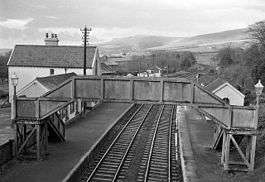Bridestowe railway station
| Bridestowe | |
|---|---|
|
Bridestowe station in 1964. | |
| Location | |
| Place | Bridestowe |
| Area | West Devon |
| Operations | |
| Pre-grouping | London and South Western Railway |
| Post-grouping | Southern |
| Platforms | 2 |
| History | |
| 12 October 1874[1] | Opened |
| 5 June 1961[2] | Closed to goods |
| 6 May 1968 | Closed to passengers[1] |
| Disused railway stations in the United Kingdom | |
|
Closed railway stations in Britain A B C D–F G H–J K–L M–O P–R S T–V W–Z | |
|
| |
Bridestowe railway station served the 2 miles or so distant village of Bridestowe in West Devon, England, located outside Okehampton on the edge of Dartmoor.
History
It was built by the Okehampton Railway, an independent company that was supported by the London and South Western Railway (LSWR). On the 17 July 1862 the company was authorised to build a line from Coleford Junction near Crediton, to Okehampton. Before construction began the line was leased to the LSWR and an extension authorised to Lidford. This was almost the highest point on the LSWR line.
Renamed as the Devon and Cornwall Railway and construction began in 1864 and the line to Lidford was opened on 12 October 1874.[3] Lidford was renamed as Lydford on 3 June 1897.[4] The station was closed in 1968 together with the stretch of line from Okehampton to Bere Alston.
The Devon and Cornwall Company was taken over by the LSWR in 1872,[5] which was in turn incorporated into the Southern Railway in the grouping of railways in 1923.
The disused Bridestowe railway station is now converted to a private dwelling. When rabbit warrening was an important rural industry on Dartmoor, Bridestowe sent away annually many more rabbits than passengers, mostly to London. It was used by several Dartmoor mining industries and also the Rattlebrook Peatworks which closed in 1921; it was an ordnance depot during the Second World War.[6]
| Preceding station | Disused railways | Following station | ||
|---|---|---|---|---|
| Lydford | Exeter to Plymouth London and South Western Railway |
Okehampton | ||
References
- Notes
- Sources
- Anthony, GH; Jenkins, SC (1997). The Launceston Branch. Headington: Oakwood Press. ISBN 978-0-85361-491-3.
- Mitchell, David (1994). British Railways Past and Present - Devon. Peterborough: Past and Present Publishing. p. 90. ISBN 1-85895-058-9.
- Nicholas, John (1992). The North Devon Line. Sparkford: Oxford Publishing Company. ISBN 0-86093-461-6.
- St John Thomas, David (1973). West Country Railway History. Newton Abbot: David and Charles. p. 102. ISBN 0-7153-6363-8.
Coordinates: 50°39′56″N 4°05′32″W / 50.66567°N 4.092158°W
